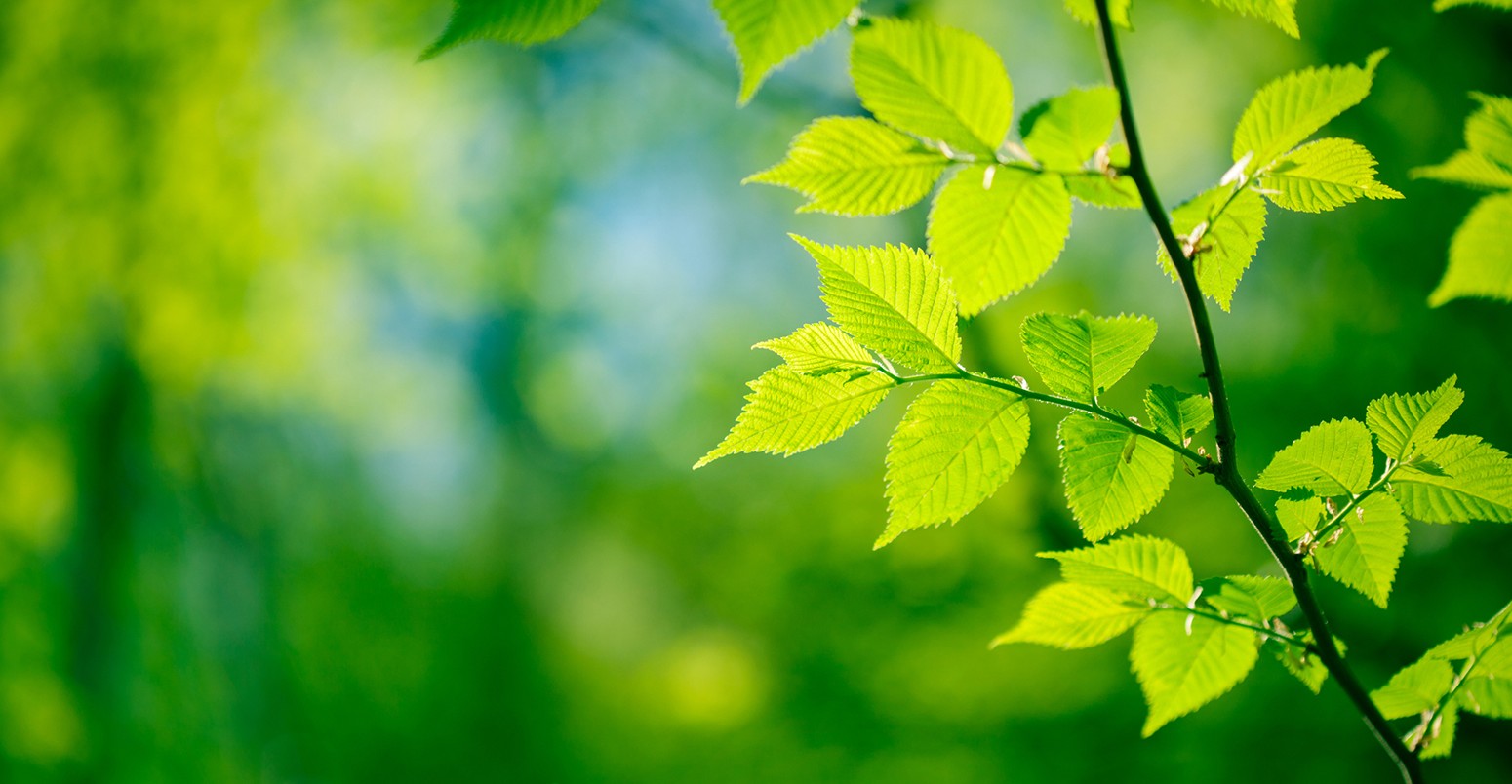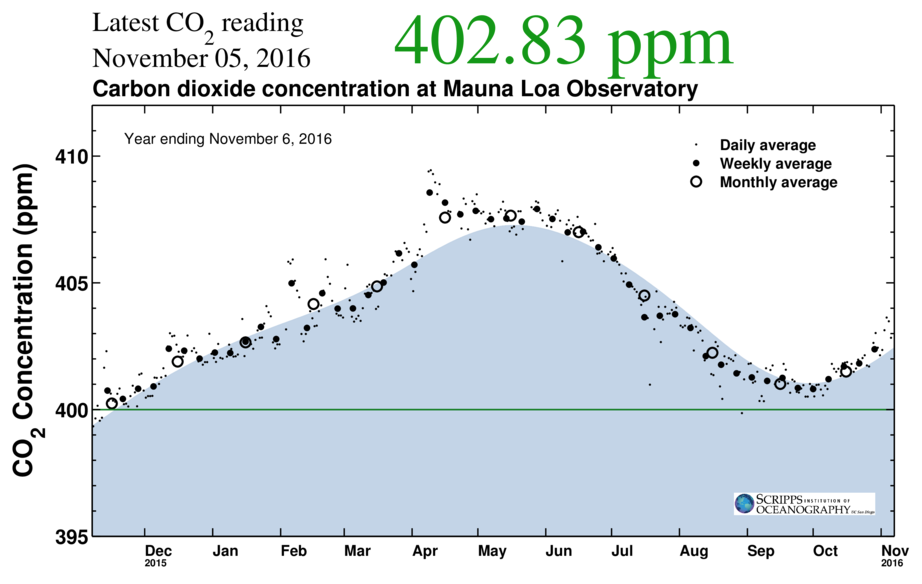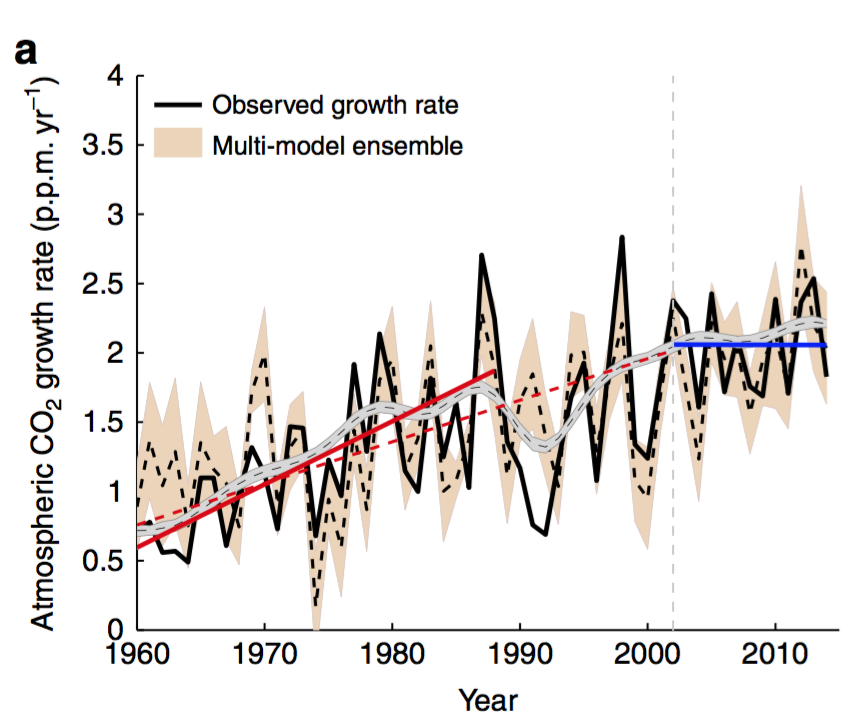
Surge in plant growth explains slower CO2 rise over past decade
Roz Pidcock
11.08.16It’s unequivocal that human activity is raising CO2 levels in the atmosphere. But since the start of the century, the level has stopped accelerating and has taken on more of a steady rise instead.
This is the conclusion of a new study published in Nature Communications that looks at the factors controlling how plants on land “breathe” CO2, causing the upward march in atmospheric CO2 to periodically speed up and slow down.
Between 2002-2014, plants took up CO2 more readily than in previous decades, leaving a smaller proportion in the atmosphere, the study explains. But this is not a reason to relax, says Prof Richard Betts, head of climate impacts research at the Met Office Hadley Centre, who wasn’t involved in the study. He tells Carbon Brief:
In fact, we are already seeing a return to faster CO2 rise as ecosystems respond to the strong El Niño weather phenomenon in 2015/16, says Betts.
Rising CO2
Human activities, such as burning fossil fuels and making cement, release CO2 into the atmosphere. In the mid 1850s, before humans started industrialising, the concentration of CO2 in the atmosphere was around 280 parts per million (ppm). In 2016, for the first time, it stayed above 400ppm for the full year.

For the first time, the atmospheric CO2 concentration at Mauna Loa stayed above the symbolic milestone of 400ppm for the full year in 2016, including September’s seasonal low. Source: UC San Diego
In a guest post for Carbon Brief, timed to coincide with today’s study, Betts explains the history of CO2 measurements and how scientists were able to predict when we would breach the 400ppm mark.
Today’s study explains how the land and oceans “breathe” some of the CO2 we release into the atmosphere, removing about 45% of what we humans put in there each year. These carbon “sinks” act as a natural buffer against rising emissions, reducing the amount of warming we experience.
The amount of CO2 plants take up doesn’t stay the same all the time, as Betts’s guest post explores in more detail. And, according to today’s paper, the amount of CO2 that the land is absorbing has been “especially strong” recently, counteracting more of our rising emissions than usual.
For three decades, from 1959 to 1990, the rate at which CO2 in the atmosphere increased grew from 0.75 ppm per year to 1.75 per year. Put another way, the rate of change more than doubled. From 2002-2014, however, the growth rate held fast at a steady 2.1ppm per year. Dr Trevor Keenan, from the Lawrence Berkeley National Lab in California and lead author on the study, tells Carbon Brief:

Observed and modelled rise in the atmospheric CO2 growth rate from 1960-2012. Vertical grey line indicates departure from increasing trend (1959-1990, solid red; 1959-2002, dashed red) to no evident trend (2002-2014, blue). Source: Keenan et al., (2016)
‘Greening’
Since the amount of CO2 human activity released to the atmosphere grew rapidly from 2000-2014, the authors had to look elsewhere for what could explain the slower CO2 growth rate. Keenan tells Carbon Brief:
Keenan is referring to the amount of carbon stored by land plants. Plants convert sunlight, water and CO2 into glucose during a process known as photosynthesis, in order to grow. More CO2 in the air means plants can photosynthesise faster, as long as they’re not limited by water or nutrients.
This effect, known as CO2 fertilisation, is most evident at high latitudes and has been recognised in the scientific world for decades. But while the general principles are understood, less is known about how they will alter under future conditions that have not yet been experienced, says Betts.
Change of pace
As well as rising emissions between 2002-2014 boosting photosynthesis, something else was happening to further increase the amount of carbon stored in plants.
To release energy from the glucose produced during photosynthesis, plant cells respire. This process produces CO2, but it is sensitive to temperature. During the first part of the 21st century, average global temperatures at Earth’s surface rose slower than in previous decades, slowing the pace of respiration.
As the paper notes:
The slowdown in respiration contributed to more CO2 staying locked up in plants rather than ending up in the atmosphere, though to a lesser extent than the CO2 fertilisation effect.
Interestingly, the authors of today’s study call the transition from an accelerated CO2 growth rate to a steady one a “pause”. But Prof Pierre Friedlingstein, professor of global carbon cycle modelling at the University of Exeter, finds the word choice “confusing and certainly not helpful”. He tells Carbon Brief:
Reversal of fortunes
To put today’s study in wider context, it’s also important to look past the end of the study period. With the pace of CO2 rise picking up again in 2015/16 because of a very strong El Niño, the situation is already changing.
El Niño is a periodic weather phenomenon in the tropical Pacific that affects temperature and rainfall patterns worldwide. During an El Niño event, CO2 tends to rise faster because warm, dry conditions on tropical land areas weaken the carbon sink. Prof Corinne Le Quéré, director of the Tyndall Centre at the University of East Anglia, sums up today’s study:
Looking further ahead, scientists warn that as temperatures continue to rise, the delicate balance of how trees use CO2 could be upset, potentially reducing their capacity to buffer rising CO2 levels. As Betts writes in his Carbon Brief guest post:
Or, as Prof Dave Reay, chair in carbon management at the University of Edinburgh, puts it:
Today’s study highlights the need to protect natural vegetation so it can continue to do the important job of absorbing our carbon emissions, say the authors. However, while humanity has so far been buffered from the full impact of our carbon emissions due to the natural carbon sinks on land and ocean, we should not assume that this will continue at the same level indefinitely, they warn.
Keenan, T. et al. (2016) Recent pause in the growth rate of atmospheric CO2 due to enhanced terrestrial carbon uptake. Nature Communications DOI: 10.1038/ncomms13428

